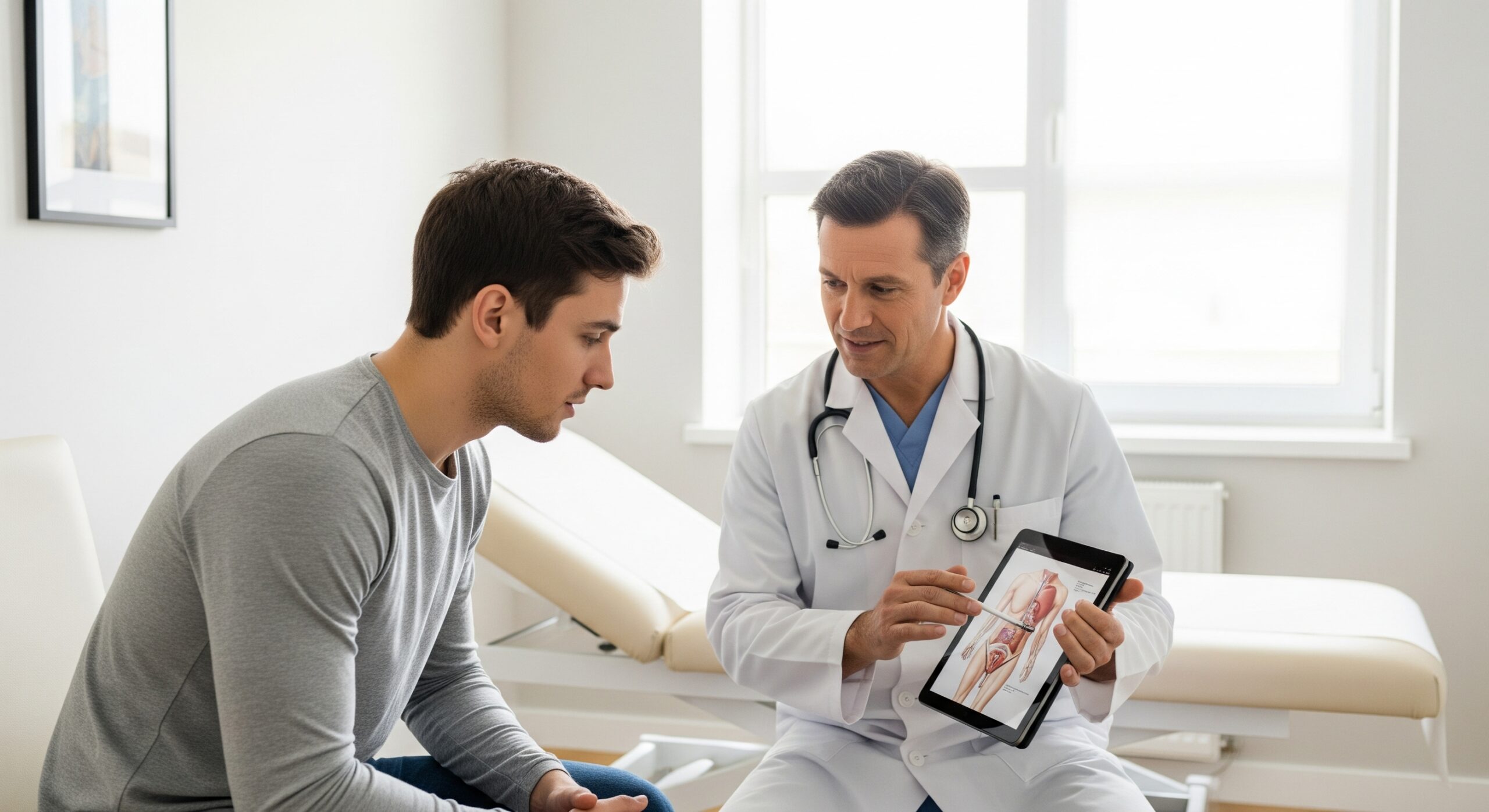Dealing with sudden testicular pain or swelling? It might be more than just discomfort—it could be epididymitis. This common condition happens when the epididymis (the coiled tube behind the testicle that stores and carries sperm) becomes inflamed, often due to infection. It can affect men of all ages and, if left untreated, may lead to serious complications.
The good news? With the right care, it’s usually treatable. In this article, we’ll break down the symptoms to watch for, what causes epididymitis, how it’s diagnosed, and the treatment options that can help you feel better fast.
Understanding Epididymitis
What is Epididymitis?
Epididymitis is an inflammation of the epididymis, a coiled tube at the back of the testicle that stores and carries sperm. This condition can cause significant discomfort and may affect fertility if not treated promptly. It is most common in men aged 18 to 50, with over 600,000 medical visits annually in the United States, according to the Centers for Disease Control and Prevention (CDC).
- Inflammation of the epididymis
- Common in men aged 18-50
- It can affect fertility if untreated
The Male Reproductive System and Epididymis
The male reproductive system includes several key structures, with the epididymis playing a crucial role in sperm maturation and storage. Located behind each testicle, the epididymis is essential for the proper functioning of the male reproductive system. Understanding its role helps in recognizing the impact of epididymitis.
- The epididymis stores and matures sperm
- Located behind each testicle
- Essential for male reproductive health
Acute vs. Chronic Epididymitis
Epididymitis can be classified as acute or chronic. Acute epididymitis develops suddenly and is often more severe, while chronic epididymitis persists for more than six weeks and may have milder symptoms. Recognizing the type of epididymitis is crucial for effective treatment.
- Acute: sudden onset, severe symptoms
- Chronic: lasts over six weeks, milder symptoms
- Treatment varies based on type
Symptoms of Epididymitis
Common Signs and Symptoms
Epididymitis symptoms can vary but often include pain and swelling in the scrotum, fever, and discomfort during urination. These symptoms can significantly impact daily life and require medical attention for proper management.
- Pain and swelling in the scrotum
- Fever and chills
- Discomfort during urination
Acute Epididymitis Symptoms
Acute epididymitis symptoms are typically more intense and may include severe scrotal pain, redness, and warmth. These symptoms often require immediate medical intervention to prevent complications.
- Severe scrotal pain
- Redness and warmth in the scrotum
- Requires immediate medical attention
Chronic Epididymitis Symptoms
Chronic epididymitis symptoms are generally less severe but persistent, including mild discomfort and swelling. These symptoms can be challenging to manage and may require long-term treatment strategies.
- Persistent mild discomfort
- Swelling in the scrotum
- Long-term management may be needed
Causes and Risk Factors
Bacterial Infections
Bacterial infections are a common cause of epididymitis, often resulting from urinary tract infections or sexually transmitted infections. These infections can lead to inflammation and require antibiotic treatment.
- Often caused by bacterial infections
- Linked to urinary tract infections
- Requires antibiotic treatment
Sexually Transmitted Infections
Sexually transmitted infections (STIs) like chlamydia and gonorrhea are significant causes of epididymitis in sexually active men. Safe sexual practices can help reduce the risk of these infections.
- Chlamydia and gonorrhea are common causes
- Affects sexually active men
- Safe practices reduce risk
Non-Infectious Causes
Non-infectious causes of epididymitis include trauma, autoimmune diseases, and certain medications. Identifying these causes is essential for appropriate treatment.
- Trauma and autoimmune diseases
- Certain medications can cause inflammation
- Requires a different treatment approach
Risk Factors for Developing Epididymitis
Several risk factors increase the likelihood of developing epididymitis, including unprotected sex, recent surgery, and a history of urinary tract infections. Awareness of these factors can aid in prevention.
- Unprotected sex and recent surgery
- History of urinary tract infections
- Awareness aids prevention
Diagnosis of Epididymitis
Physical Examination
A physical examination is the first step in diagnosing epididymitis, allowing healthcare providers to assess symptoms and rule out other conditions. This examination is crucial for accurate diagnosis.
- Initial step in diagnosis
- Assesses symptoms and rules out other conditions
- Crucial for accurate diagnosis
Laboratory Tests
Laboratory tests, including urine and blood tests, help identify the presence of infections and guide treatment decisions. These tests are essential for confirming the cause of epididymitis.
- Urine and blood tests identify infections
- Guides treatment decisions
- Essential for confirming the cause
Imaging Studies
Imaging studies, such as ultrasounds, provide detailed views of the scrotum and can help identify abnormalities. These studies are often used when physical exams and lab tests are inconclusive.
- Ultrasounds provide detailed views
- Identifies abnormalities
- Used when other tests are inconclusive
Treatment Options for Epididymitis
Antibiotics for Bacterial Infections
Antibiotics are the primary treatment for bacterial epididymitis, targeting the underlying infection. Prompt antibiotic treatment can prevent complications and promote recovery.
- Primary treatment for bacterial infections
- Targets the underlying infection
- Prevents complications
Pain Management and Supportive Care
Pain management and supportive care, including rest and scrotal elevation, are essential for relieving symptoms. These measures can significantly improve comfort during recovery.
- Rest and scrotal elevation
- Essential for symptom relief
- Improves comfort during recovery
Surgical Interventions for Severe Cases
In severe cases, surgical intervention may be necessary to address complications such as abscess formation. Surgery is typically a last resort when other treatments fail.
- Necessary for severe cases
- Addresses complications like abscesses
- Last resort when other treatments fail
Complications of Epididymitis
Fertility Issues
Epididymitis can lead to fertility issues if not treated promptly, as inflammation can affect sperm production and transport. Early treatment is crucial to prevent long-term effects on fertility.
- Can affect sperm production and transport
- Early treatment prevents long-term effects
- Crucial for maintaining fertility
Chronic Pain
Chronic pain is a potential complication of epididymitis, particularly in cases that are not adequately treated. Managing pain effectively is essential for quality of life.
- Potential complications if untreated
- Effective pain management is essential
- Impacts quality of life
Abscess Formation
Abscess formation is a serious complication that may require surgical intervention. Recognizing and treating abscesses early can prevent further complications.
- Serious complications requiring surgery
- Early treatment prevents further issues
- Recognizing abscesses is crucial
Prevention Strategies
Safe Sexual Practices
Safe sexual practices, including the use of condoms, can significantly reduce the risk of sexually transmitted infections and subsequent epididymitis. Education on safe practices is vital.
- Use of condoms reduces risk
- Education on safe practices is vital
- Reduces the risk of STIs and epididymitis
Proper Hygiene
Proper hygiene, including regular washing and care of the genital area, can help prevent infections that lead to epididymitis. Maintaining hygiene is a simple yet effective prevention strategy.
- Regular washing and care of genital area
- Prevents infections leading to epididymitis
- Simple and effective prevention strategy
Regular Check-Ups
Regular medical check-ups can help detect and treat infections early, reducing the risk of developing epididymitis. Routine health assessments are an important preventive measure.
- Detects and treats infections early
- Reduces the risk of epididymitis
- Important preventive measure
Living with Epididymitis
Managing Symptoms at Home
Managing symptoms at home involves rest, scrotal support, and over-the-counter pain relief. These measures can help alleviate discomfort and promote healing.
- Rest and scrotal support
- Over-the-counter pain relief
- Alleviates discomfort and promotes healing
When to Seek Medical Attention
It is important to seek medical attention if symptoms worsen or do not improve with home care. Early intervention can prevent complications and ensure effective treatment.
- Seek help if symptoms worsen
- Early intervention prevents complications
- Ensures effective treatment
Final Thoughts
Epididymitis is a common condition that can cause significant discomfort and potential complications if not treated promptly. Understanding the symptoms, causes, and treatment options is essential for effective management and prevention. By adopting safe practices and seeking timely medical care, individuals can reduce their risk and maintain reproductive health.
FAQs
What can be mistaken for epididymitis?
Epididymitis can be mistaken for other conditions, such as testicular torsion or orchitis due to similar symptoms. Accurate diagnosis through medical evaluation is essential to differentiate these conditions and ensure appropriate treatment.
What is the difference between epididymitis and orchitis?
Epididymitis is the inflammation of the epididymis, while orchitis refers to inflammation of the testicle itself. Both conditions can occur simultaneously, known as epididymo-orchitis, and require medical evaluation for proper treatment.
Does epididymitis go away on its own?
Epididymitis typically requires medical treatment, especially if caused by a bacterial infection. While mild cases may improve with home care, seeking medical advice is crucial to prevent complications and ensure complete recovery.


